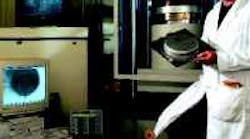NIST post doctoral research fellow Mark Iadicola examines a sample of sheetmetal tested with NIST's new formability-testing station.
RESEARCHERS AT THE NATIONAL Institute of Standards and Technology (NIST) want to eliminate defects in dies used to make sheetmetal parts. Their work could yield impressive cost savings — particularly for the automotive industry, which spends an estimated $700 million a year on designing, testing, and correcting new dies for its latest models. About half of the total cost goes for remedying unanticipated errors manifested as wrinkles, splits, excessive thinning, or other defects.
Using NIST's one-of-a-kind test equipment, which fits together a metal-stamping test station with an X-ray stress-measurement system, researchers make detailed maps of stresses and strains as sheets of steel and other metals are punched, stretched, or otherwise shaped to achieve the desired part geometry. According to project leader Tim Foecke, the system measures stress and strain behavior in many different directions while the sheet is stretched in two directions simultaneously, a condition most commonly seen in forming operations.
Current methods extrapolate from strain-measurement testing that stretches sheets in only one direction. As a consequence, newly designed dies often undergo successive rounds of refinement to correct for these simplifications in computer models.
U.S. automakers and producers of steel, aluminum, and other metals, including developmental ones, are supplying Foecke's team with samples for testing and evaluation. The aim of the project is to build a database of material properties that designers can feed into computer models for predicting whether would-be dies can form particular metals into specified shapes, within tolerances. Project findings might point the way to new metalforming methods, according to NIST.

